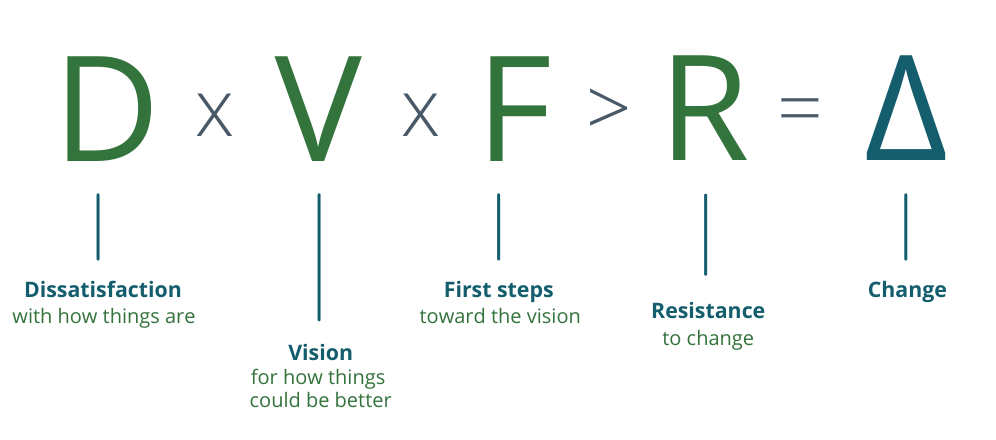This is the second article in a series on Change, which might seem like an unexpected topic for a financial advising firm to cover, but since most people worry about their money and our mission is to help them think beyond their money, change is an obstacle we help all our client’s face.
Read the first article: Why Change is Hard
Behavioral models of change from the field of organizational psychology help us better understand how and why it is so natural to resist new things that would improve our lives. The formula below was developed for organizations but is also helpful when considering the interconnected factors that make change difficult for individuals.

It is helpful to think of the variables in this equation (D, V, F and R) as having numeric values. When doing this, you will note the following:
- If D, V and F are all positive numbers, the product of multiplying them together will be positive (meaning change is possible).
- If D, V or F is zero, the product of multiplying them together will be zero (meaning change is not possible).
- If R is large, the product of D, V and F must be larger for change to be possible.
Making a change requires an understanding of all four variables, since successful change is only possible when the product of your dissatisfaction with how things are going (D), vision for how you want things to be (V) and the first steps you can take toward that vision (F) are greater than your resistance to change (R).
Four Truths about Change (and Life)
- When you are comfortable, you are unlikely to do anything that would make you uncomfortable. But if you are dissatisfied with how things are, change is possible…and might even be welcomed.
- We all need a compelling vision of the future before attempting to change. The more compelling the vision, the more motivated (and hopeful) we will be to achieve it.
- Successful and lasting change requires a roadmap. We do not have to know all the steps before starting, but we at least need to know the first steps.
- It is important to be aware of your dissatisfaction, vision, and the first steps, but you must also be aware of your resistance to change…what is holding you back?
The Life Alignment™ process we guide financial planning clients through provides the structure to develop a compelling vision for your future and the guidance to take the first steps while navigating your resistance to change. We call this “thinking beyond your money,” and it involves embracing your values, clarifying your purpose and considering your legacy.
“When your values are clear, decisions are easy.” – Roy Disney
Read the next article: The Enemy of Change






